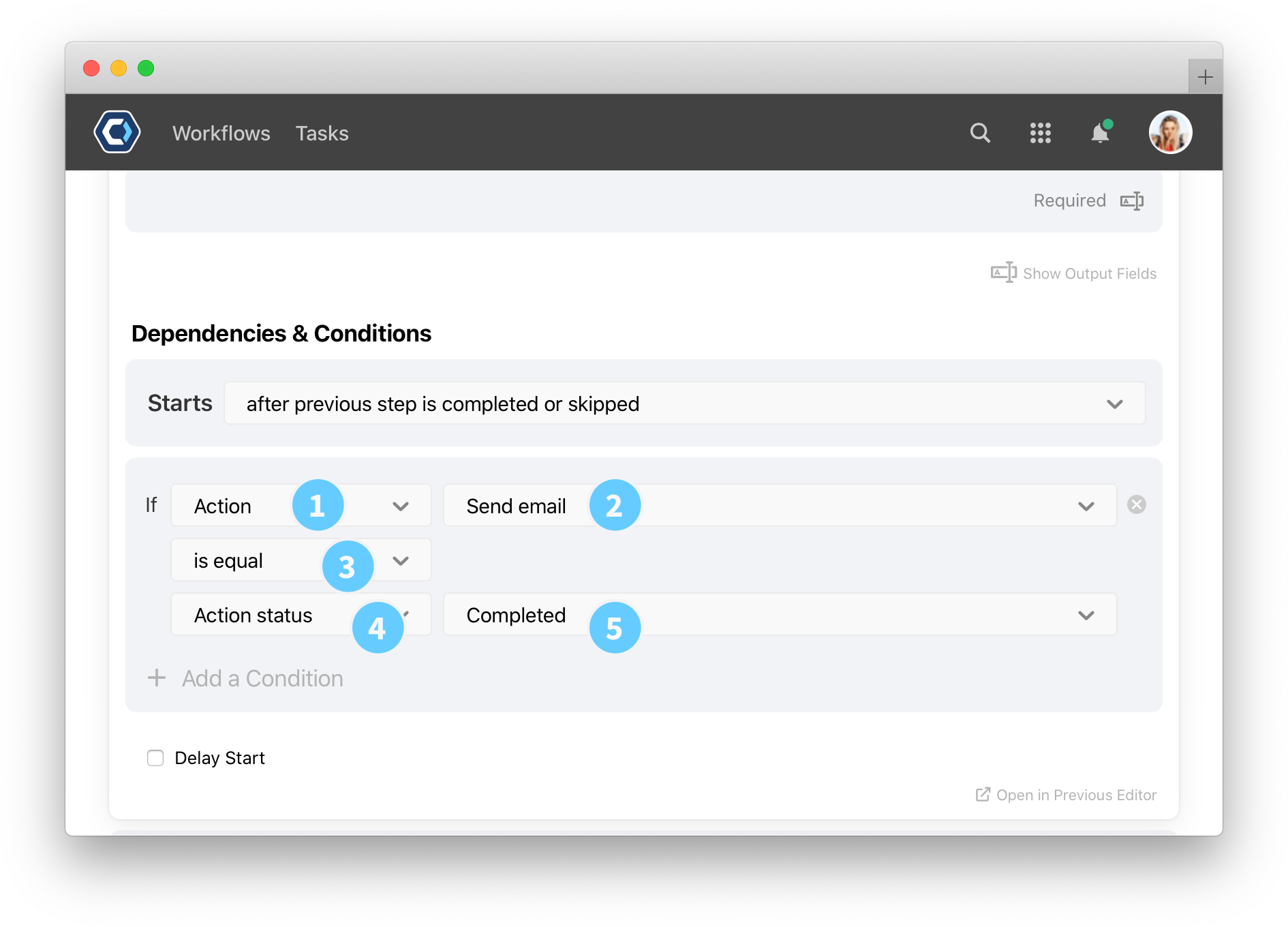 Start an action only when a condition is met
Start an action only when a condition is met
Use conditions to determine whether a task should be started or skipped based on criteria that you define. Task conditions are set per task on the configure task page.
All conditions are assessed after dependencies. Dependencies determine when a task is up next in line, then the condition is assessed to determine if the task should started or be skipped.
For information on how task conditions work in general, see Condition Options for guidance on constructing conditions and some condition basics.
Examples of use 
Conditions could be used to define workflow like these examples:
- If a vacation request is approved, then notify the requester and add a meeting to the team calendar
- If the item cost is over $10,000, then assign a task to a manager to review the expense
- If the email contains the word “refund,” then start a refund Workflow
How to add a task condition 
When setting a task condition, the task executes if the condition is true. The task is skipped is the condition is false. For example:
- If Action A is snoozed, and your condition is “If Action A is snoozed”, the task will execute.
- If Action B is not snoozed, and your condition is “If Action A is snoozed”, the task will be skipped.
-
From the Workflow Builder page, select an action, then select Conditions.

This is an example of the conditions screen - Select the type of object you want to add to the condition, then select the object, such as
ActionSend emailorTextEMEA. - Select an operator, such as
is equalorcontains. - Select the next type of object you want to add to the condition, then select the object, just like step 1.
- Add or remove a condition. Select Add a Condition to add new conditions, or select
to remove a condition.
- Select the type of object you want to add to the condition, then select the object, such as
-
Select
List of selectable condition options
To create a condition, compare two objects. To do this, select the object type, then select the value.
For example, to check if an action is completed, select the type “Action”, then select the action. Set the operator to “is equal”. Then, select the type “Action Status” and select “Completed” status.

- Field: Select from a list fields available in this Workflow.
- Field Choice: Only appears if one of the conditions is a single or multiple choice field. Select from a list of available choices.
- Text: Enter in a value, such as text or integer, to compare against. This accepts more than just strings.
- True or False: Select from True or False.
- Action: Select from a list of actions available in this Workflow.
- Action Status: Select a status that an action may have, such as “Completed” or “In Progress”
How and when conditions, dependencies, and delays are evaluated 
Every task has a status like Pending, In Progress, or Completed. Conditions are part of what determines whether a task should move from Pending (not yet started) to In Progress, and so on. Before a Pending step is set to In Progress or Skipped, the step’s dependencies, conditions, and delays are checked one by one.
Dependencies are always checked first. Afterwards, conditions are checked. If any dependency or condition is not met, the step is skipped and set to Skipped.
After dependencies and conditions are checked, the delay is checked. If the delay is not met, the step is delayed and set to Delayed. The conditions and delay are rechecked after the delay; the dependencies are not rechecked. The following video demonstrates these scenarios.
See understanding step status and milestones for more details on each status.
Get help with a problem or question 
If something’s not working as expected, or you’re looking for suggestions, check through the options below.
My conditions are not working as expected
Remember that if the conditional statement evaluates to true, the field is hidden or the task is skipped.
For example, when setting a task condition, the task executes if the condition is true. The task is skipped is the condition is false.
- If Action A is snoozed, and your condition is “If Action A is snoozed”, the task will execute.
- If Action B is not snoozed, and your condition is “If Action A is snoozed”, the task will be skipped.
Conditions are evaluated from top to bottom. In some cases, it’s necessary to rearrange the order of conditions when you have two or more conditionals linked with and and or statements. For example, it’s usually best practice to put is empty or is not empty statements last.
Thanks for your feedback
We update the Help Center daily, so expect changes soon.
Link Copied
Paste this URL anywhere to link straight to the section.

